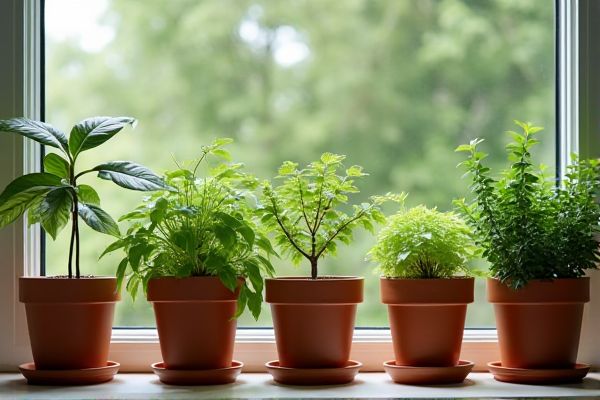
Self-watering pots provide a consistent moisture level by using a reservoir to hydrate plants, reducing the risk of over or under-watering compared to regular pots that require manual watering. Discover how choosing the right pot can transform Your gardening experience in the rest of this article.
Table of Comparison
| Feature | Self-Watering Pots | Regular Pots |
|---|---|---|
| Watering Frequency | Less frequent; water reservoir supplies moisture consistently | More frequent; requires manual watering |
| Water Usage Efficiency | High; minimizes water waste and evaporation | Lower; prone to overwatering or underwatering |
| Plant Health | Improved; steady moisture promotes healthy root growth | Variable; risk of inconsistent moisture levels |
| Maintenance | Low; refill reservoir as needed | High; regular watering and monitoring required |
| Cost | Higher initial investment | Lower initial cost |
| Ideal Use | Busy gardeners, indoor plants, drought-prone areas | Traditional gardening, plants needing precise watering |
Introduction to Self-Watering Pots vs Regular Pots
Self-watering pots utilize a reservoir system that provides consistent moisture to plants, reducing the frequency of watering compared to regular pots. These containers improve water efficiency by minimizing evaporation and runoff, promoting healthier root development. In contrast, regular pots require more frequent manual watering, which can lead to inconsistent moisture levels and increased risk of overwatering or underwatering.
How Self-Watering Pots Work
Self-watering pots operate by utilizing a reservoir system that supplies water directly to plant roots through capillary action, promoting consistent moisture levels and reducing the risk of over or underwatering. This mechanism encourages deeper root growth and healthier plants by providing a steady water supply without frequent manual watering. In contrast, regular pots rely entirely on surface watering, which can lead to uneven soil moisture and more frequent watering needs.
Traditional Pots: Features and Functions
Traditional pots are typically made from materials like clay, ceramic, or plastic, allowing for versatile design and size options suited to various plant types. They rely on manual watering, requiring you to monitor soil moisture regularly to prevent over- or under-watering. These pots offer excellent drainage through built-in holes, promoting healthy root aeration and reducing the risk of root rot.
Watering Efficiency and Plant Health
Self-watering pots improve watering efficiency by delivering a consistent moisture level through a built-in reservoir, reducing water waste and promoting deep root growth. Regular pots rely on manual watering, often leading to overwatering or underwatering, which can stress plants and hinder development. Consistent hydration in self-watering pots enhances plant health, reducing root rot and nutrient leaching compared to traditional pot methods.
Maintenance Requirements: A Comparison
Self-watering pots drastically reduce maintenance requirements by providing a consistent moisture level through an internal reservoir, minimizing the need for frequent watering and preventing overwatering. Regular pots demand more attentive care since soil moisture fluctuates more easily, increasing the risk of root rot or dehydration if watering is irregular. You will save time and effort with self-watering pots, especially in maintaining healthy plant growth during busy schedules or dry climates.
Cost Analysis: Self-Watering vs Regular Pots
Self-watering pots typically have a higher upfront cost compared to regular pots due to built-in reservoirs and advanced materials, but they can save money over time by reducing water usage and minimizing plant loss from under- or over-watering. Regular pots are more affordable initially but may incur additional costs with frequent watering, plant maintenance, and soil replacements. Your investment in self-watering pots often pays off by promoting healthier plants and lowering water bills, making them cost-effective in the long run.
Best Plants for Each Pot Type
Succulents, herbs, and indoor tropical plants thrive in self-watering pots due to their consistent moisture levels, reducing the risk of underwatering or overwatering. Regular pots are ideal for plants like orchids, cacti, and some flowering plants that prefer well-drained soil and less frequent watering. Choose based on your plant's moisture needs to ensure optimal growth and health.
Sustainability and Environmental Impact
Self-watering pots reduce water waste by delivering precise moisture to plants, promoting water efficiency and conserving natural resources. Their design minimizes runoff and soil erosion, leading to healthier plants with less environmental degradation compared to regular pots requiring frequent watering. Incorporating self-watering systems supports sustainable gardening practices by lowering water consumption and reducing the carbon footprint associated with traditional irrigation methods.
Common Problems and Solutions
Self-watering pots address common problems like inconsistent watering and root rot by providing a steady moisture supply through a built-in reservoir, ensuring your plants receive optimal hydration without overwatering. Regular pots often suffer from waterlogging or dry soil, which can stress plants and stunt growth; this is typically mitigated by frequent manual watering and proper drainage techniques. Choosing a self-watering pot can simplify maintenance and promote healthier root development, solving common issues faced with traditional pots.
Choosing the Right Pot for Your Needs
Self-watering pots provide consistent moisture to plants through a built-in reservoir, reducing the risk of overwatering and promoting healthier root growth. Regular pots offer more control over watering frequency but require frequent monitoring to prevent drying or waterlogging. Selecting the right pot depends on your plant species, watering habits, and desired maintenance level for optimal growth and convenience.
 homyna.com
homyna.com